
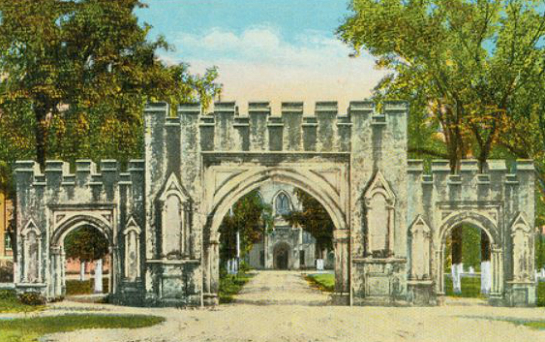
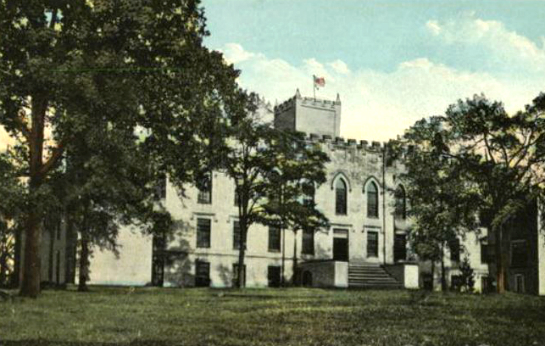
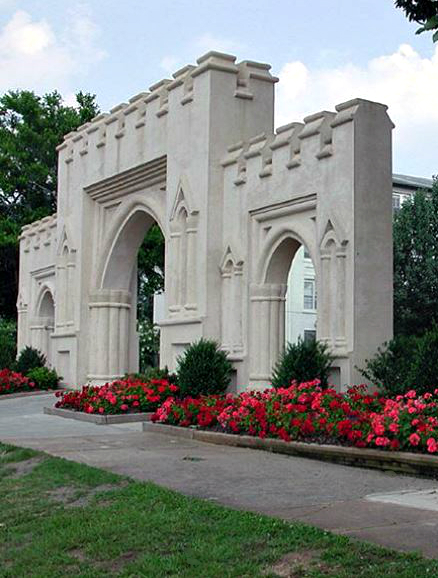
| Gateway to the "Strange Western Country" ~ Georgia's Old Statehouse & the Governor's Passports ~ |
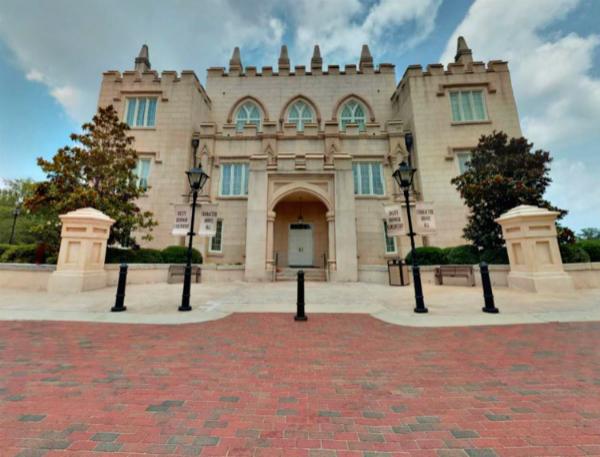
From 1804 until 1868, the town of Milledgeville, Georgia served as the capital of that
state. Prior to that the colonial capital had been located in Savannah and then, for a
short time, in Louisville. Construction of Milledgeville's state capitol building, shown
above, was completed in 1807.
In 1868, the capital was moved to Atlanta and the old capitol building was used as the
court house for Baldwin County from 1871 until 1879. It was then used for the Middle
Georgia Military and Agricultural College, which, in 1900, became Georgia Military
College.
Between 1785-1820, citizens of the United States who desired to go to or travel
through the Creek or Cherokee Nations and proceed to the "Western Territory" had to
obtain passports from Georgia's governor. Only people who could persuade the
governor that they were of good character were allowed to travel through or settle in
the Spanish or Indian Territories to the west.
The records associated with the passports languished unnoticed, gathering dust, for
many years at the Georgia Department of Archives and History, until Mary Bryan, the
department's Director in the 1950's, found them and, with painstaking care, performed
the tedious task of transcribing them. These records have proven to be of invaluable
assistance to family researchers. The people who desired to move to the new frontier
were not only from the state of Georgia, but from all points east.
They were published in two books, first, in 1959, the records from 1785-1809; and,
then, the records from 1810-1820 were published in 1964.
The following is from the first book, "Passports Issued by Governors of Georgia,
1785-1809" by Mary G. Bryan:
"[At first] the object was to view the country, with an eye to moving; then they began to
ask for passports to go as settlers, sometimes to the "strange western country" or to the
"Tombigby", "the Louisiana country", "the Mississippi territory", "Orleans country",
"Natchez territory" or the "Spanish Providence." One request was to go into the "foreign
country of west Georgia."
"Letters are constantly received by the Department of Archives from citizens [seeking
information about their ancestors]. By consulting these passports they can be informed not
only from whence they came and the time, but also of the object of their going, the number
of members of their family and, as equally important, the names of their neighbors and
friends who vouched for them."
Most of the people in this early westward migration would have come through the
statehouse in Milledgeville, Georgia to obtain passports.
The old capitol building remains on the campus of Georgia Military College and is
open for tours. I can't help wondering if the halls still echo with the footsteps of the
pioneers who came seeking permission to start a new life in the "strange western
country."
Some of my own ancestors among them.
-- Nancy
state. Prior to that the colonial capital had been located in Savannah and then, for a
short time, in Louisville. Construction of Milledgeville's state capitol building, shown
above, was completed in 1807.
In 1868, the capital was moved to Atlanta and the old capitol building was used as the
court house for Baldwin County from 1871 until 1879. It was then used for the Middle
Georgia Military and Agricultural College, which, in 1900, became Georgia Military
College.
Between 1785-1820, citizens of the United States who desired to go to or travel
through the Creek or Cherokee Nations and proceed to the "Western Territory" had to
obtain passports from Georgia's governor. Only people who could persuade the
governor that they were of good character were allowed to travel through or settle in
the Spanish or Indian Territories to the west.
The records associated with the passports languished unnoticed, gathering dust, for
many years at the Georgia Department of Archives and History, until Mary Bryan, the
department's Director in the 1950's, found them and, with painstaking care, performed
the tedious task of transcribing them. These records have proven to be of invaluable
assistance to family researchers. The people who desired to move to the new frontier
were not only from the state of Georgia, but from all points east.
They were published in two books, first, in 1959, the records from 1785-1809; and,
then, the records from 1810-1820 were published in 1964.
The following is from the first book, "Passports Issued by Governors of Georgia,
1785-1809" by Mary G. Bryan:
"[At first] the object was to view the country, with an eye to moving; then they began to
ask for passports to go as settlers, sometimes to the "strange western country" or to the
"Tombigby", "the Louisiana country", "the Mississippi territory", "Orleans country",
"Natchez territory" or the "Spanish Providence." One request was to go into the "foreign
country of west Georgia."
"Letters are constantly received by the Department of Archives from citizens [seeking
information about their ancestors]. By consulting these passports they can be informed not
only from whence they came and the time, but also of the object of their going, the number
of members of their family and, as equally important, the names of their neighbors and
friends who vouched for them."
Most of the people in this early westward migration would have come through the
statehouse in Milledgeville, Georgia to obtain passports.
The old capitol building remains on the campus of Georgia Military College and is
open for tours. I can't help wondering if the halls still echo with the footsteps of the
pioneers who came seeking permission to start a new life in the "strange western
country."
Some of my own ancestors among them.
-- Nancy
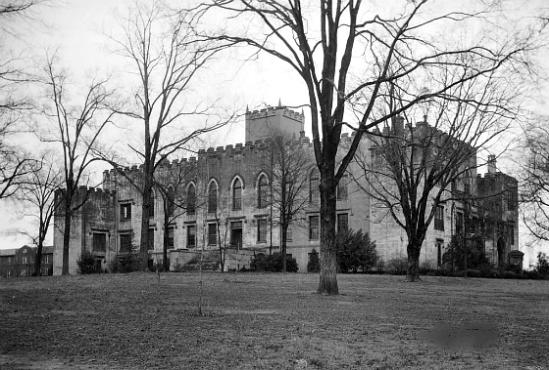
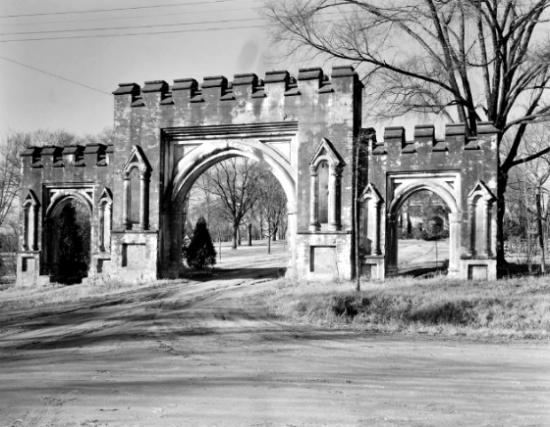
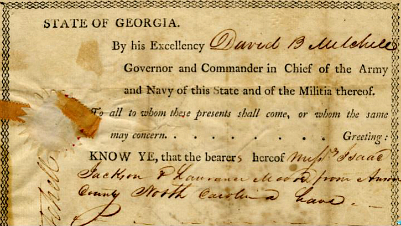
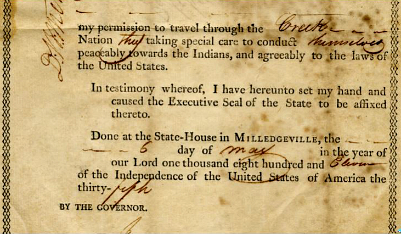
| In all of the records located in the archives relating to passports, only two of the passports themselves were found, perhaps application had been made and the passports approved, but never picked up. One of those is shown above; it reads (to the best of my deciphering ability): State of Georgia By his Excellency David B. Mitchell, Governor and Commander in Chief of the Army and Navy of this State and of the Militia thereof. To all to whom these present shall come, or whom the same may concern, Know ye that the bearers hereof Isaac Jackson _?_ _?_ from Anson County, North Carolina have my permission to travel through the Creek Nation, they taking special care to conduct themselves peaceably towards the Indians and agreeably to the laws of the United States. In testimony hereof I have hereunto set my hand and caused the Executive Seal of the State to be affixed thereto. Done at the State-House in Milledgville, the 6 day of May in the year of our Lord one thousand eight hundred and eleven and of the Independence of the United States of America, the thirty-fifth. |
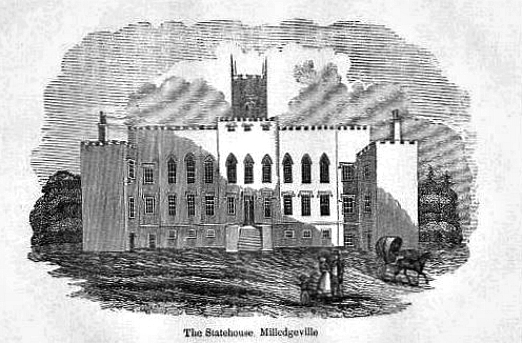
| Illustration of the statehouse, 1847 |
| Above & below, vintage postcards of the building and gate, dates unknown |
| Above & below, building and gate, 1930's |
| Cadets pictured after the school became Georgia Military College in 1900. |
| Below are a few samples of applications from the passport records. 18 October 1803 Whereas William McCall is desirous of exploring the Western Territory of the state of Georgia and some parts of the Orleans in the Spanish dominions, he applied to me for a recommendation. We do hereby certify that we have been well acquainted with the said McCall, both in private and public capacities, and he is of unblemished character. Therefore, we hope for the patronage of any gentleman that should see him in a distressed situation. Signed, Lewis Lanier, Wm. McKennedy, Josiah Everitt, John Lewther, Charles MCall ~~~ 16 September 1809 Whereas the bearer William Simmons being about leaving His place of nativity in Fairfield District, South Carolina, in order to travel into Strange Countries, these are therefore to acquaint all people that he has been brought up under very honest reputable parents and has always behaved himself as behove the character of every honest inoffensive sober industrious young man, and as such we herein recommend him to all inquiring people. Signed, James Alston, Jeremiah Taylor, Lewis Haigood ~~~ 17 December 1819 Evan Price has business of importance to transact in the Creek and Cherokee Nations and he wishes a passport to authorize him to go there. I have for many years been acquainted with Mr. Price and can with propriety recommend him as an honest respectable citizen. Signed, Robert Rees |
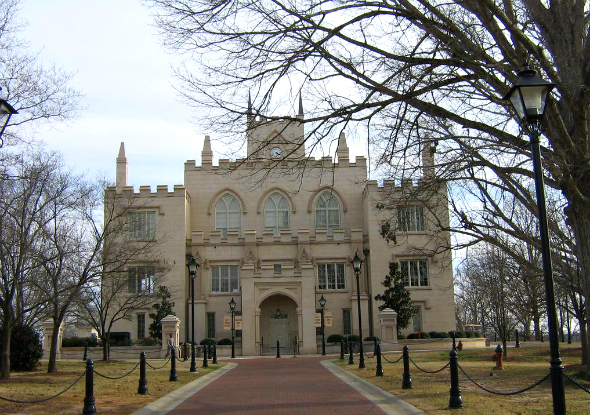
| Related pages: Old Photographs of Milledgeville Homes Ghost Whispers Photo Credits: 1930's photos: Library of Congress |
| If you'd like to see if your ancestors applied for a passport, here's the link to an index of Mary Bryan's books: Index to "Passports Issued by Governors of Georgia" The link to this page is: http://old-new-orleans.com/Milledgeville.html Back to My G-Grandfather's Attic Back to Whispers |
...
| Old Milledgeville Statehouse, the oldest public building of its type in the United States. |